
The city’s bikeways map is lit up in at least six colors. Routes range from future, planned, scheduled, in progress and on hold, to complete — a patchwork of edges on top of the city’s expansive street grid.
Metro planners see the city as a riddle. This month, the city’s Department of Transportation and Multimodal Infrastructure (NDOT) will roll out its Connect Downtown plan, an attempt to map out smoother ways to move people through the urban core. Planners talk about downtown as a black box: People go in and people come out. In between, it’s a mess of Ubers, scooters, one-way streets and jaywalking, without clear arteries connecting east to west or north to south. Downtown’s rapid shift in use from a business center for suburban commuters to today’s pedestrian playground has tasked NDOT with a clunky game of catchup.
Modern urbanism draws emphasis away from cars — the pollution-making, space-wasting vestiges of the 20th century — and toward walking, biking and communal transit like buses and subways. Hardcore New Urbanists say phasing out cars is a matter of life and death, considering the risk high-speed vehicles pose to pedestrians, cyclists and other drivers, especially in the age of distracted driving. Last year was the deadliest on record for Nashville, which saw 47 pedestrians and two cyclists killed by cars.
A damning report from Forbes last month put even more heat on city leaders to figure out the city’s transportation growing pains. The national business magazine ranked Nashville as the country’s hardest commute, estimating that residents lost 41 hours over 2022 to traffic and congestion obstacles. Mayor Freddie O’Connell addressed the report at a press briefing in late October.
“Not only was Nashville ranked among the worst cities for commute times, but buried within that, some factors were independently assessed,” O’Connell explained. “We fared poorly on our walk score, bike score and transit score. It is certainly this administration’s intent to get reports back on those before Thanksgiving. We want safer infrastructure.”
Big headline projects — like a pedestrian-only zone on Lower Broadway or the city’s aspirational bus rapid transit line from the airport — move slowly. In the meantime, bike lanes have become visible deliverables slowly piecing together a network for Nashville cyclists.
How the Tennessee Department of Transportation hopes to make road work zones safer for workers, drivers and pedestrians
Planners hosted an open house last month on 31st Avenue North, where NDOT converted a car lane into a bikeway between Park Plaza and West End. That section of road is part of a key crosstown connector gradually changing from Rosa Parks to Ed Temple to 31st to Blakemore to Wedgewood as it loops around the city — a “necklace,” in planner shorthand. Each new segment expands territory for Nashville cyclists.
“The biggest concerns for a cyclist like me, who relies on my bike, is safety and having to constantly reorient yourself to maximize safety between protected lanes,” says Patrick Reilly, a Vanderbilt University graduate student. “There are unreachable places for me, and there are many straightforward routes that are just not available.”
Reilly doesn’t own a car and relies on his bike as a primary means of transportation. Major routes like Hillsboro Road are a no-go because they’re crowded with fast-moving cars. Each new bike lane allows him to tweak his routes across the city, reorienting them to maximize safety.
“Gallatin [Pike] is the most efficient way to shoot up into East Nashville, but the safest route is taking Davidson through Shelby Park to Riverside,” says Reilly. “A bike commuter will take a more circuitous route to remain in a protected bike lane as much as possible. If I can’t do that, I need to take safety risks to make it somewhere.”
Bike lane construction on a massive section of Lebanon Pike is underway right now. Sections of Douglas Avenue, South 14th Street, South Street, Gale Lane and Clifton Avenue are getting lanes too. Downtown is crisscrossed with current and future bike projects that will also help divert scooter traffic away from cars.
If it seems like bike lanes are suddenly popping up everywhere, it’s because they’re riding a combination of modern urban design principles and a planning department trying desperately to help Nashville catch up.






